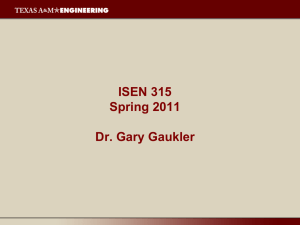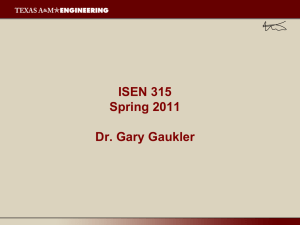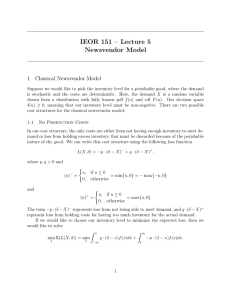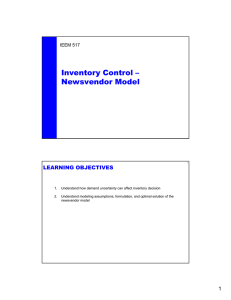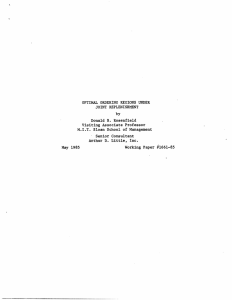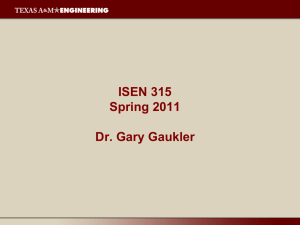Newsvendor alternative
advertisement
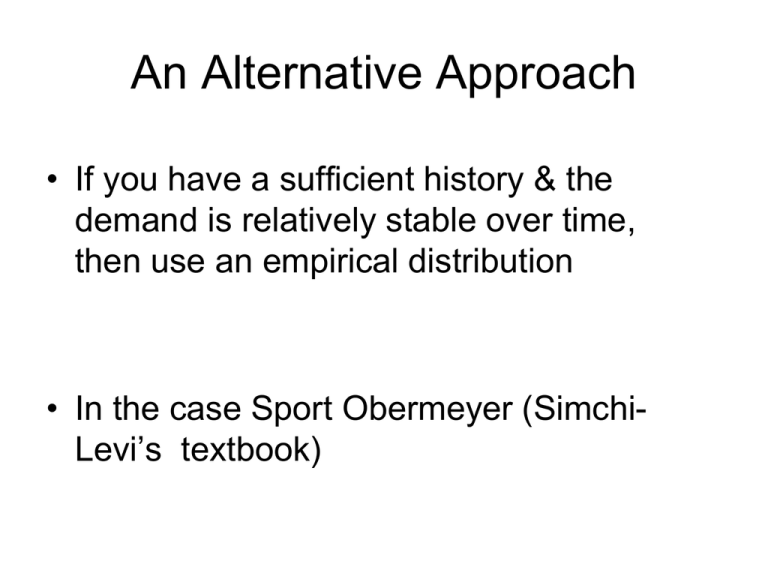
An Alternative Approach • If you have a sufficient history & the demand is relatively stable over time, then use an empirical distribution • In the case Sport Obermeyer (SimchiLevi’s textbook) An Example • Demand for a Weekly Magazine in the past 52 weeks (Computer Today) 15 19 9 12 9 22 14 11 6 11 9 18 10 5 4 17 18 14 15 8 9 4 6 7 12 15 15 19 4 7 8 11 0 14 12 9 10 8 9 16 8 11 11 18 15 17 19 14 14 17 13 12 Frequency Histogram 7 Weeks 6 5 4 3 2 1 0 0 2 4 6 8 10 12 14 Actual Demand 16 18 20 22 Demand 30 28 26 24 22 20 18 16 14 12 10 8 6 4 2 0 -2 -4 -6 Frequency Continuous Distribution 7 6 5 4 3 2 1 0 Normal Distribution Parameters (mu, sigma^2): D 11.73 s 4.74 The Newsboy Model: an Example Mr. Tan, a retiree, sells the local newspaper at a Bus terminal. At 6:00 am, he meets the news truck and buys # of the paper at $3.0 and then sells at $7.0. At noon he throws the unsold and goes home for a nap. If average daily demand is 50 and he buys just 50 copies daily, then is the average daily profit =50*4 =$200? NO! The Intuition • There is a tradeoff between ordering too much and ordering too little • To balance these forces, it’s useful to think in terms of a cost for ordering too much and a cost for ordering too little – A cost here can be a loss of profit Deriving the Formula: Critical Ratio • Overstocking cost C0 = loss incurred when a unit unsold at end of selling season • Understocking cost Cu = profit margin lost due to lost sale (because no inventory on hand) In the example: C0 = -3, Cu = 4 Let P(d<=k) = Prob (d <= k) Additional contribution keep order size at k 1 more unsold order k+1 instead of k 1 fewer lost sale -3 =Co 4 Cu Order k+1 instead of k if 4*P(d k+1) - 3*P(d<k) > 0 or 4*[1-P(d<k)] - 3*P(d< k ) > 0 Increase order from k to k+1 if Prob(Demand < k) < 4 =0.57 3+4 Newsvendor ModelDemand Distribution Continuous Q Order Q such that Prob(Demand < Q) = Critical ratio r(Q) Cu Co + C u If F* = 0.65, z = 0.385 Normal Dist. Q*=100 +0.385*20 Q*=aver.+z*stdev If F* =0.45, z= -0.125 0.0 0.1 0.2 0.3 0.4 0.5 0.6 0.7 0.8 0.9 1.0 1.1 1.2 1.3 1.4 1.5 1.6 1.7 1.8 1.9 2.0 2.1 0.00 0.5000 0.5398 0.5793 0.6179 0.6554 0.6915 0.7257 0.7580 0.7881 0.8159 0.8413 0.8643 0.8849 0.9032 0.9192 0.9332 0.9452 0.9554 0.9641 0.9713 0.9772 0.9821 0.01 0.5040 0.5438 0.5832 0.6217 0.6591 0.6950 0.7291 0.7611 0.7910 0.8186 0.8438 0.8665 0.8869 0.9049 0.9207 0.9345 0.9463 0.9564 0.9649 0.9719 0.9778 0.9826 If F* =0.45, z= -0.125 F(z) Q* = 100 – 0.125*20 z If F* = 0.65, z = 0.385 Q* = aver. + z*stdev 0 z 0.02 0.5080 0.5478 0.5871 0.6255 0.6628 0.6985 0.7324 0.7642 0.7939 0.8212 0.8461 0.8686 0.8888 0.9066 0.9222 0.9357 0.9474 0.9573 0.9656 0.9726 0.9783 0.9830 0.03 0.5120 0.5517 0.5910 0.6293 0.6664 0.7019 0.7357 0.7673 0.7967 0.8238 0.8485 0.8708 0.8907 0.9082 0.9236 0.9370 0.9484 0.9582 0.9664 0.9732 0.9788 0.9834 0.04 0.5160 0.5557 0.5948 0.6331 0.6700 0.7054 0.7389 0.7704 0.7995 0.8264 0.8508 0.8729 0.8925 0.9099 0.9251 0.9382 0.9495 0.9591 0.9671 0.9738 0.9793 0.9838 0.05 0.5199 0.5596 0.5987 0.6368 0.6736 0.7088 0.7422 0.7734 0.8023 0.8289 0.8531 0.8749 0.8944 0.9115 0.9265 0.9394 0.9505 0.9599 0.9678 0.9744 0.9798 0.9842 0.06 0.5239 0.5636 0.6026 0.6406 0.6772 0.7123 0.7454 0.7764 0.8051 0.8315 0.8554 0.8770 0.8962 0.9131 0.9279 0.9406 0.9515 0.9608 0.9686 0.9750 0.9803 0.9846 0.07 0.5279 0.5675 0.6064 0.6443 0.6808 0.7157 0.7486 0.7794 0.8078 0.8340 0.8577 0.8790 0.8980 0.9147 0.9292 0.9418 0.9525 0.9616 0.9693 0.9756 0.9808 0.9850 0.08 0.5319 0.5714 0.6103 0.6480 0.6844 0.7190 0.7517 0.7823 0.8106 0.8365 0.8599 0.8810 0.8997 0.9162 0.9306 0.9429 0.9535 0.9625 0.9699 0.9761 0.9812 0.9854 0.09 0.5359 0.5753 0.6141 0.6517 0.6879 0.7224 0.7549 0.7852 0.8133 0.8389 0.8621 0.8830 0.9015 0.9177 0.9319 0.9441 0.9545 0.9633 0.9706 0.9767 0.9817 0.9857 • Purchasing cost $0.25/per copy,selling price =$ 0.75。If unsold after the week, each copy can be salvaged at $0.1 (to be returned to the publisher)。 What’s the optimal order quantity Q? • F(Q) = co 0.25 - 0.10 0.15 cu 0.75 - 0.25 0.50 0.50 F (Q ) 0.77 0.15 0.50 * • f(x) Area=0.77 4.74 11.73 Q* demand, d • From the previous normal table,z=0.74。 Thus optimal weekly order quantity Q* 11.73 0.74 4.74 15.24 15 or 16 Who is the better manager? Consider two managers using the newsvendor model • Manager A never has inventory left over • Manager B usually has inventory left over Cu F (Q) Cu C0 Cu = 0.5 Co = 2 r (y ) = 0.5/2.5 = 0.2 Who is the better manager? Consider two managers using the newsvendor model • Manager A never has inventory left over • Manager B usually has inventory left over What if they both sell Valentine’s cards: Cu=$2.00 Co=$0.20 r (Q) = 2/2.2 = 0.91 Cu r( Q ) Cu C0 Cu = 0.5 Co = 2 r (y ) = 0.5/2.5 = 0.2 END

